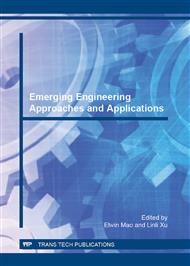[1]
Yu Jen Hu, Yuh Hua Hu, Jyh Bin Ke, The Modified RNA Identification Classification on Fuzzy Relation, Applied Mechanics and Materials Vols. 48-49, pp.1275-1281, (2011).
DOI: 10.4028/www.scientific.net/amm.48-49.1275
Google Scholar
[2]
M. L. Phillips, Crime Scene Genetics: Transforming Forensic Science through Molecular Technologies. BioScience, vol. 58, 484-489, (2008).
DOI: 10.1641/b580604
Google Scholar
[3]
P. W. Lisette, P. David, Noninvasive Genetic Sampling Tools for Wildlife Biologists: a review of applications and recommendations for accurate data collection, Journal of Wildl. Manage. 1419-1433. vol 69, (2005).
DOI: 10.2193/0022-541x(2005)69[1419:ngstfw]2.0.co;2
Google Scholar
[4]
Xiaohong Wang, Jun Huan, Aaron Smalter, Gerald H Lushington, Application of kernel functions for accurate similarity search in large chemical databases, Journal of BMC Bioinformatics, (2010).
DOI: 10.1186/1471-2105-11-s3-s8
Google Scholar
[5]
Yung Wei Sun, Wen Yi Liao, Han Tsu She, Ming Chung Liu, Yu Ju Liao, Yu Ching Tsai, Chi Hsiung, Junn Jih Chen, Use of Molecular for Species Identification in Paphiopedilum, Taiwan Flower Expo flower posters of new technology magazine, pp.183-186, (2004).
Google Scholar
[6]
Chun fen Zhou, Hong wen Peng, Biological Information Easily Learn., Hop Kee Book Press, (2005).
Google Scholar
[7]
General Biology-Gene expression of the genetic code, National Yang-Ming University network materials.
Google Scholar
[8]
Brain Hayes, The Invention of the Genetic Code, American Scientist-Computing Science,Jan. -Feb., (1998).
Google Scholar
[9]
RNA Forensic Science Encyclopedia, R.O. C, http: /www. cib. gov. tw/science/Science0201. Aspx? DOC_ID = 00007.
Google Scholar
[10]
M. Zhang, M. X. Cheng, T. J. Tarn, A Mathematical Formulation of RNA Computation, Journal of IEEE Transaction on Nanobioscience , vol. 5, no. 1, (2006).
Google Scholar
[11]
L. M. Adleman, Molecular Compution of Solutions to Combinatorial Problems, Journal of Science 1021-1024, VOL. 266, (1994).
Google Scholar
[12]
P. H. William, F. Christophe, G. S. Brian, Fuzzy Species Among Recombinogenic Bacteria, Journal of BMC Bioinformatics, 3: 6, (2005).
Google Scholar
[13]
Summer basic molecular biology techniques. Genetic Engineering Center, National Chung Hsing University, Taichung, Taiwan, (1999).
Google Scholar
[14]
National Pingtung University of Science and Technology, biotechnology, basic experiment, Rui Yu Press, Pingtung, Taiwan, P221, (1998).
Google Scholar
[15]
ZENG Yi Xiong, Chen Xinfen, Ching-San Chen, Electrophoretic Separation Symposium, National Science Council, Taipei, Taiwan, 98, (1987).
Google Scholar
[16]
Sambrook, J., E. F. Fritsch, and T. Maniatis. Molecular Cloning: a Laboratory Manual. Cold Spring Harbor Laboratory, Cold Spring Harbor, NY. (1989).
DOI: 10.1002/jobm.19840240107
Google Scholar
[17]
Li Jianwu et al, principles and methods of biochemical experiments, Yixuan Book Publishing, P114-146, (2002).
Google Scholar


